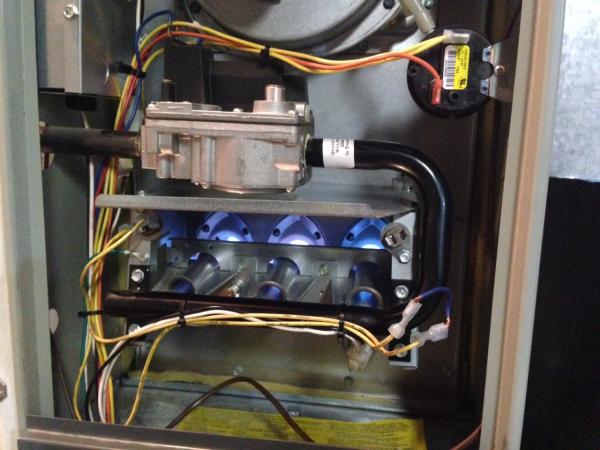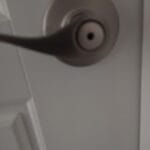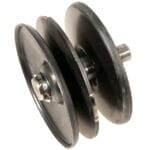Is your furnace refusing to take a break and running nonstop? You’re not alone.
A furnace that won’t turn off can be a major headache, leading to higher energy bills and potential wear and tear on your heating system. You’re probably wondering why it’s happening and, more importantly, how you can fix it before it becomes a bigger problem.
You’ll discover the common reasons why your furnace might be acting up and learn practical solutions you can apply right away. Keep reading to find out how you can ensure your home stays warm without burning through your wallet. Your comfort—and peace of mind—are just a few steps away.

Credit: www.acservicetech.com
Common Causes Of A Non-stop Furnace
If your furnace won’t turn off, it can be both puzzling and frustrating. Understanding the common causes is your first step to solving the issue. Let’s dive into what might be going wrong, so you can take actionable steps to get your heating system back under control.
Thermostat Issues
Sometimes, the problem lies within the thermostat. Have you checked if it’s set to the correct mode? A simple mistake in setting it to ‘ON’ instead of ‘AUTO’ can keep the furnace running non-stop. Also, older thermostats might have wiring issues or be affected by dust build-up. You might be surprised how often a quick dusting or a battery change resolves the problem.
Faulty Limit Switch
A faulty limit switch might be keeping your furnace on continuously. This switch is responsible for shutting the furnace off once it reaches a certain temperature. If it’s malfunctioning, the furnace might not get the signal to stop. You might need a professional to check or replace this component. It’s a small part, but it plays a huge role in the system’s operation.
Clogged Air Filters
Dirty air filters can lead to overheating, causing the furnace to keep running. When was the last time you changed yours? A clogged filter restricts airflow, making the furnace work harder to maintain temperature. Regularly replacing your filters can prevent this issue and also improve air quality in your home. It’s a simple maintenance step with big benefits.
Leaky Ductwork
Leaky ducts can lead to heat loss, prompting the furnace to run longer to reach the desired temperature. Have you ever checked your ductwork for leaks? Even small holes or gaps can make a significant difference in efficiency. Properly sealed ducts help maintain consistent heat, reducing unnecessary furnace operation. You might need professional help for a thorough inspection.
Have you encountered any of these issues before? Addressing them might be the key to solving your non-stop furnace problem. Regular maintenance can prevent many of these issues. What steps are you taking to ensure your furnace runs efficiently?
Troubleshooting Thermostat Problems
Is your furnace refusing to turn off, leaving you in a sweltering indoor climate? The culprit might be your thermostat. This small device is crucial for regulating your home’s temperature. If it’s malfunctioning, your furnace might continue its relentless operation. Let’s explore some common thermostat problems and how you can troubleshoot them effectively.
Check Thermostat Settings
Before diving into repairs, inspect your thermostat settings. Have you accidentally switched it to a ‘Continuous’ or ‘Fan’ mode? This setting can keep your furnace running non-stop. Ensure it’s set to ‘Auto’ for proper operation. Sometimes, a simple switch can solve the problem.
Think about your daily routine. Are there times when you manually adjust settings? You might unknowingly override your programmed schedule. Regularly check and update these settings to match your lifestyle.
Battery Replacement
Have you ever forgotten to replace your thermostat batteries? This oversight can lead to erratic behavior. Weak batteries may disrupt signals, causing your furnace to stay on longer than intended. Check the battery indicator and replace them if needed.
Opt for high-quality batteries. They last longer and ensure consistent performance. Keep a spare set handy for emergencies. It’s a small investment that can save you from heating headaches.
Calibration Needs
Is your thermostat calibrated correctly? Miscalibration can lead to inaccurate temperature readings. This can cause your furnace to overwork, maintaining temperatures that aren’t necessary. A simple recalibration can often fix this issue.
Have you noticed any significant temperature discrepancies? If your room feels warmer or cooler than the thermostat indicates, it’s time for recalibration. Consider consulting a professional if you’re unsure how to proceed.
What steps have you taken to troubleshoot your thermostat issues? Share your experiences below. Your insights can help others facing similar challenges.
Inspecting The Limit Switch
Experiencing issues with a furnace that won’t turn off often leads to inspecting the limit switch. This component helps regulate the furnace’s temperature, ensuring it doesn’t overheat. Malfunctions here can prevent the furnace from shutting down correctly.
When your furnace won’t turn off, it can be a frustrating experience. Among the various components that could be causing this issue, the limit switch is a critical one to inspect. This small device plays a big role in regulating the furnace’s temperature and ensuring it operates safely. If it’s malfunctioning, your furnace might run continuously, leading to energy waste and potential damage.Signs Of A Faulty Limit Switch
A faulty limit switch can manifest in several ways. You might notice your furnace blower running constantly, even when the desired temperature is reached. This can lead to higher energy bills and unnecessary wear on your system. Another sign is inconsistent heating. If your home has hot and cold spots, the limit switch might not be functioning properly. It’s essential to catch these signs early to prevent further complications. In some cases, you might hear unusual noises from the furnace. These could be rattles or clicks when the system is running. Paying attention to these auditory cues can help you pinpoint the issue.Diy Testing Steps
Before you call a professional, there are a few steps you can take to test the limit switch yourself. First, make sure to turn off the power to your furnace for safety. Then, locate the limit switch, which is usually found on the furnace’s main blower housing. Using a multimeter, you can check if the switch is functioning. Set the multimeter to the ohms setting and touch the probes to the switch’s terminals. A reading of zero indicates a closed switch, which is normal when the furnace is off. If the multimeter shows no reading, the switch might be stuck open. In this case, gently pressing the reset button on the switch could resolve the problem. Always remember, if you’re unsure, it’s better to seek professional help.When To Call A Professional
While DIY testing can be a good first step, there are times when you should call in a professional. If the furnace continues to run nonstop after your tests, a technician’s expertise is necessary. Professionals have the tools and experience to diagnose deeper issues. For instance, if the limit switch needs replacement, they can ensure it’s done correctly. This prevents further complications and ensures your furnace is safe to use. Consider how much time and energy you’re spending on this issue. Is it worth risking a larger repair bill down the line? Sometimes, getting a professional opinion early can save you both money and stress.
Credit: www.youtube.com
Replacing Or Cleaning Air Filters
A dirty air filter can cause a furnace to run non-stop. Replacing or cleaning the air filter may solve this issue. Regular maintenance ensures efficient operation and prevents unnecessary energy use.
Replacing or cleaning air filters is crucial for a furnace’s efficiency. Dirty air filters can cause a furnace to run constantly. This not only wastes energy but also raises your utility bills. Regular maintenance helps avoid these issues and extends the life of your furnace.Identifying Dirty Filters
Check your air filter every month. Look for dust or dirt buildup. A clean filter should allow light to pass through. If light can’t pass, it’s time to clean or replace it. A clogged filter can block airflow. This forces your furnace to work harder, causing it to stay on longer.Step-by-step Replacement Guide
Turn off your furnace before starting. Locate the air filter compartment. Remove the old filter carefully. Note the size printed on the filter’s frame. Insert the new filter in the same direction as the old one. Make sure it fits snugly. Close the compartment, and turn the furnace back on.Benefits Of Regular Maintenance
Regular filter checks improve indoor air quality. Clean filters trap dust and allergens. This helps you breathe easier. It also reduces wear and tear on your furnace. Less strain means fewer repairs. This saves money in the long run. Plus, a well-maintained furnace uses less energy, lowering utility bills. Regular maintenance ensures your furnace runs efficiently.Addressing Ductwork Leaks
Addressing ductwork leaks is crucial when your furnace won’t turn off. Leaks in the ductwork can lead to inefficiencies, causing your furnace to work overtime. By fixing these leaks, you not only save energy but also ensure that your home maintains a comfortable temperature. Let’s dive into how you can detect leaks, apply temporary fixes, and implement long-term solutions for your ductwork.
Detecting Leaks
Finding ductwork leaks can be tricky. A simple way to start is by checking for visible cracks or gaps in the duct system. You might notice a draft or feel cold air escaping from these areas.
Another method is turning on your furnace and using a smoke pencil or incense stick. Hold it near the seams and joints. Watch for smoke wavering, which indicates a leak.
Don’t overlook the importance of listening. Whistling sounds when the furnace is running can signal a problem, often pointing to a leak in the ductwork.
Temporary Fixes
Once you’ve identified leaks, you might wonder what you can do immediately. One quick fix is using duct tape. Wrap it around small leaks and gaps to temporarily seal them.
Aluminum foil tape is another option. It’s more durable than regular duct tape, making it a better choice for sealing holes.
Consider using mastic sealant. It’s thick and sticky, ideal for covering larger leaks. Applying it with a brush can help bridge gaps effectively.
Long-term Solutions
Temporary fixes won’t last forever. For a permanent solution, consider professional duct sealing. Experts use advanced equipment to ensure all leaks are thoroughly sealed.
Insulating ductwork is another long-term strategy. It prevents heat loss, ensuring that the warm air reaches your rooms effectively. This can drastically improve efficiency.
Upgrading to new ductwork might be necessary if leaks are extensive. Modern ducts are designed to be more energy-efficient, reducing the need for constant repairs.
Have you ever thought about how much energy you could save by addressing ductwork leaks? Taking action not only improves your home’s comfort but also reduces your energy bills. What steps will you take today to ensure your furnace runs efficiently?

Credit: cityheatandair.com
When To Seek Professional Help
A furnace that won’t turn off could signal a malfunction. This issue may require professional help to ensure safety. Ignoring persistent heating problems might lead to energy waste or potential hazards.
When your furnace refuses to turn off, it can be more than just an inconvenience. It’s a clear sign that something is wrong, and sometimes, it’s not something you can fix on your own. Knowing when to call in the professionals can save you time, money, and a great deal of frustration. Let’s explore some situations where professional help is the best course of action.Complex Repairs
If you’ve tried the basic troubleshooting steps like adjusting the thermostat or checking the power supply and your furnace still runs non-stop, it might be time to call a professional. Certain issues, like a malfunctioning relay or a wiring problem, require specialized knowledge and tools. Attempting to fix these on your own can lead to further damage or even voiding your warranty. A professional technician can quickly diagnose the problem and ensure your furnace is operating efficiently.Warranty Considerations
Did you know that DIY repairs can void your furnace’s warranty? Most warranties require that all maintenance and repair work be performed by certified technicians. If your furnace is relatively new and still under warranty, you’ll want to make sure you’re not inadvertently voiding it by trying to fix it yourself. Review your warranty terms. It might specify the type of repairs covered and who is authorized to perform them. Calling in a professional not only keeps your warranty intact but also provides peace of mind.Safety Concerns
Your safety should always be a priority. Furnaces, especially gas ones, can pose significant risks if not handled correctly. Issues like gas leaks or carbon monoxide emissions are not only dangerous but potentially life-threatening. If you suspect any such problem, it’s crucial to contact a professional immediately. They have the expertise to safely manage and resolve these hazards. Remember, it’s not just about fixing your furnace; it’s about ensuring your home is a safe place for you and your family. When your furnace starts acting up, consider the risks versus rewards of handling the repairs yourself. Are you equipped to deal with complex systems, or is it worth bringing in an expert? Protect your investment, your warranty, and most importantly, your home’s safety by knowing when to seek professional help.Frequently Asked Questions
Why Won’t My Furnace Turn Off?
Check thermostat settings. It might be set incorrectly. Also, inspect for stuck relays causing continuous operation.
Could A Dirty Filter Keep The Furnace Running?
Yes, a dirty filter restricts airflow. This causes the furnace to overheat, making it run continuously.
How Can Faulty Wiring Affect Furnace Operation?
Faulty wiring can cause malfunctions. It might send incorrect signals, causing the furnace to run without stopping.
Is A Broken Thermostat The Culprit?
A broken thermostat can misread temperatures. This may cause the furnace to run more than needed.
Can A Bad Limit Switch Prevent Shut-off?
Yes, a faulty limit switch might fail to signal the furnace to stop. It controls overheating safety.
Conclusion
Fixing a furnace that won’t turn off is essential. It can save energy and money. Start by checking thermostat settings. Ensure they match desired temperatures. Inspect filters and vents. Blockages may cause overheating. Listen for unusual noises. Could signal mechanical issues.
Regular maintenance prevents these problems. Professional help is sometimes necessary. Technicians can identify and resolve complex issues. Keep your home safe and warm. Understanding these steps helps everyone. Stay vigilant with your furnace care. Proper attention ensures comfort through winter months.





